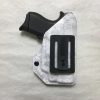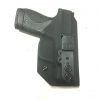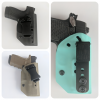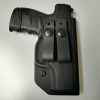To put it simply, situational awareness is using your senses to accumulate data about your immediate environment and then making choices about your behavior in relation to that environment. To make it even more simple…PAY ATTENTION! In our fast paced world, however, sometimes this is easier said than done. You have phone calls to make, kids to feed, groceries to buy, a house to clean, or, well, the list could go on and on. Often times the most important details about your surrounding environment go unnoticed, lost in the clutter, because you have failed to properly train your mind.
What details are the most important? There is not a one size fits all answer to that question because each of us has a different set of environmental stimuli to consider. A soldier on a battlefield has a different set of stimuli than a mother at the grocery store. A law enforcement officer walking a city street at night will need to pay attention to different details than a jogger on a trail through the local park. Rather than focus on which details are important, you should instead focus on the process and work to become more attuned to your senses. Enter the late USAF Colonel John Boyd and the late US Marine Jeff Cooper.
 Colonel John Boyd developed what is referred to as the OODA Loop. OODA is an acronym for Observe, Orient, Decide, and Act. The theory suggests that in any oppositional situation, the side that can process this loop the fastest will be victorious. It sounds simple, but in practice is much more complex. Situations, and especially confrontations, continually change, thus feedback from your own decisions and the decisions of adversaries will require immediate reprocessing of the loop. If you can successfully disorient and confuse your opponent enough to cause a breakdown in their OODA loop process, you will give yourself optimum chance to win.
Colonel John Boyd developed what is referred to as the OODA Loop. OODA is an acronym for Observe, Orient, Decide, and Act. The theory suggests that in any oppositional situation, the side that can process this loop the fastest will be victorious. It sounds simple, but in practice is much more complex. Situations, and especially confrontations, continually change, thus feedback from your own decisions and the decisions of adversaries will require immediate reprocessing of the loop. If you can successfully disorient and confuse your opponent enough to cause a breakdown in their OODA loop process, you will give yourself optimum chance to win.
In our own everyday lives, this theory suggests that we must continuously observe our environment and orient our attention in the direction of potential threats. When you are walking to the car after a shopping trip, OBSERVE the group of adolescents gathered a few vehicles down from your car. ORIENT your attention – have you seen these kids before? What are they wearing? Do they have any obvious weapons? Next in the loop is to DECIDE – are they an immediate threat? Should you take another route or prepare to draw a weapon? Finally, ACT – walk through the next lane and approach from a different angle or turn around and go back into the store. Once you have taken action you can then immediately begin the process over again. Fortunately, most of us will not have to deal with rapidly changing situations, such as in combat, very often. However, you can give yourself a better chance of survival if you begin to learn and practice some form of the OODA Loop in your daily life.
United States Marine and legendary defensive pistol and tactical rifle instructor Jeff Cooper emphasized that the most important tool we can use to survive a lethal confrontation is our mindset. He described these successive levels of increased awareness as different colors. Cooper’s Color Code, as it has become known, gives us a way to move from one mental state to another depending on our threat environment. The levels are as follows:
 White – Unaware and unprepared. In this state, you are left defenseless and can only hope that your attacker is a complete moron, allowing you time to escape.
White – Unaware and unprepared. In this state, you are left defenseless and can only hope that your attacker is a complete moron, allowing you time to escape.
Yellow – Relaxed but alert. In this state, you are taking in information from your surroundings, making assessments about unfamiliar sights, sounds, etc… . Generally speaking, you know that dangers exist in the world and this might be the day you have to defend yourself. If you carry a weapon for self-defense, you should be in condition yellow.
Orange – Focused alert. In this state, something specific has caught your attention and you are actively monitoring situational developments. While your weapon remains holstered/concealed, you mentally prepare for using it, deciding on a trigger that if “X” happens, I will respond with “X”. You identify your potential target(s) and are prepared for lethal action if necessary.
Red – Fight with lethal intention. Your trigger has been tripped and you fight to eliminate the threat.
As situations change you can move freely between the levels, to be properly mentally prepared to meet the challenges you face. It is important to note that this color code system was intended to help combatants deal with the internal decision making psychology of intense and potentially lethal situations. More recently, the color codes have been adopted by agencies such as the Department of Homeland Security to describe general threat conditions.
As you leave the grocery store at night and begin your walk to the car, your mental state should be condition yellow. Your head is “on a swivel” and your eyes are scanning the parking lot for any potential threats. Once you observe a threat standing near your car, your mental state should immediately jump to orange and you should begin playing the scenario out in your mind – if they approach me, I will respond with “X”. If nothing happens, you enter your vehicle and drive away. Now you can return to condition yellow, observing your new surroundings. If, however, a threat emerges, your mind and body have been “prepped” and you can launch into red and defend yourself.
In the years since their development, much has been written about the OODA Loop and Cooper’s Color Codes and, upon further study, you will learn that these methods are more complex and nuanced than the simple description presented in this article. However, if you begin to think this way in your daily life, over time you will develop better mental habits and be more prepared to defend yourself if needed.











